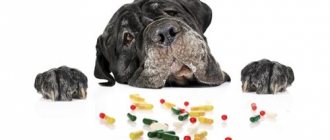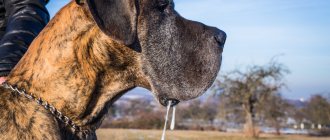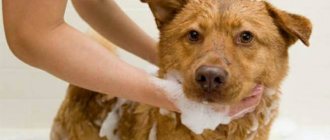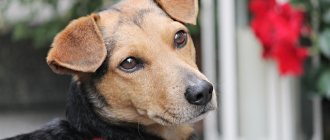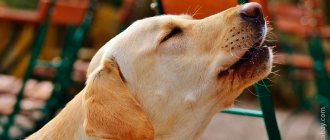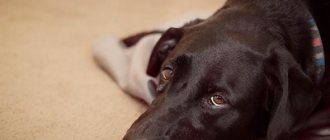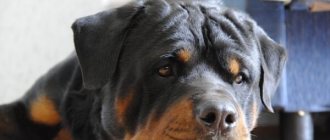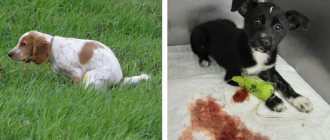Just like people, pets often suffer from digestive problems due to illness or poor dietary choices. Quite common, bloating in a dog's abdomen can be either a sign of feeding problems or a serious and sometimes fatal problem. If the animal has barely noticeable bloating, which goes away after taking the medications, the owners will simply have to reconsider their attitude to the dog’s diet. But if the condition worsens and the bloating increases, this already becomes a threatening sign, and the owners need to urgently seek veterinary help, otherwise the dog may die.
What is ascites in a dog
What is ascites in a dog
Ascites in dogs (dropsy) is a pathological condition accompanied by the accumulation of a large amount of free fluid in the abdominal cavity of the animal. It creates excess pressure on internal organs and interferes with their normal functioning.
The fluid that accumulates in the dog's abdomen can be transudate, exudate, or modified transudate. And its volume can reach 20 liters.
Signs of illness
Acute bloating in a dog poses a direct threat to its life if it is accompanied by the following symptoms:
- Complete refusal to eat. It is especially dangerous if the dog does not drink water at all - this threatens rapid dehydration.
- Severe enlargement of the abdomen - it is swollen and reacts painfully to touch.
- The dog can barely walk, her hind legs are swollen, and she prefers to lie on her side.
- The animal is salivating.
- Nausea and frequent vomiting with foamy and foul-smelling contents.
If a dog exhibits such symptoms, it should be immediately examined and treated.
Causes and types of ascites
Ascites in dogs is not an independent disease and always develops as a result of serious inflammatory and non-inflammatory pathologies that impair absorption and blood circulation.
The main causes of dropsy include:
- Kidney diseases. This organ acts as a filter that removes toxins. Kidney pathologies lead to malfunction of the kidneys, which results in fluid stagnation.
- Parasitic and infectious diseases. Due to the activity of pathogenic microorganisms, toxins are released that trigger inflammatory processes.
- Injuries to the abdominal cavity, causing inflammation, swelling or intracavitary bleeding.
- Oncological diseases. Cancer cells are characterized by rapid growth of fibers of the emerging tumor. When placed in the internal organs, the neoplasm provokes a violation of the outflow of lymph, as a result of which fluid can accumulate in the peritoneum.
- Pathologies of the heart muscle. In heart failure, the heart cannot cope with pumping the required volume of blood, which results in dropsy.
- Liver diseases. This organ passes impressive volumes of blood and lymph. Liver dysfunction is fraught with filtration failure and stagnation, causing ascites.
- Peritonitis. The pathology is accompanied by a loss of elasticity of the peritoneal muscles, making it difficult to remove fluid. The result is dropsy.
- Unbalanced diet with high sodium content and lack of proteins and vitamins.
Ascites is not divided into types and may differ in the degree of inhibition of certain organs. But usually dropsy provokes disruption of the functioning of the entire body.
When should you take it to the vet?
If the dog is suffering from a huge belly, nausea, is breathing heavily, and can barely move, you need to urgently take him to a veterinary clinic .
In difficult situations, call a doctor at home.
Also pay attention to vomiting: how often does your pet urge. If the dog vomits 1-2 times and feels better, the body copes on its own. To prevent dehydration, give Regidron.
Vomiting more than 3-4 times a day with a putrid odor, foam or yellow color is a reason to consult a doctor.
Obvious symptoms of gastric volvulus: refusal to eat, excessive salivation with frequent vomiting. It is advisable not to delay it even in cases where mild symptoms last more than 1 day.
At the clinic, the animal is thoroughly examined: an X-ray, ultrasound, urine and feces samples are taken, and a puncture of the cavity fluid is performed to determine the contents. The doctor will also listen in detail and record your medical history. First of all, he will ask how long ago the dog took anti-worm medications. The main task is to stop the bloating process by flushing the stomach through a tube inserted into the throat. Piercing the peritoneum with a special hollow needle also helps remove gases: it is not recommended to do this on your own at home. A pet in shock is given special medications to relieve pain with antibiotics. Intensive treatment is also carried out, prescribing peristalsis stimulants and supportive therapy for the cardiovascular system. In severe cases, emergency surgery under anesthesia is prescribed. The positive outcome of the surgical intervention depends on the speed with which the animal was delivered to the veterinary hospital. After surgery, it is important to provide quality care and successfully go through the postoperative period.
Symptoms and dangers
Ascites in a dog: symptoms
Symptoms of dropsy depend on the severity of the pathology and the volume of fluid accumulated in the peritoneum. The most characteristic sign of ascites in dogs is a symmetrically distended abdomen.
With dropsy, a lot of fluid accumulates in the pet’s peritoneum and when the body position changes, the belly takes on a different shape. If you lay a dog on its back, its belly will spread out to the sides, like a frog's. If the dog is placed on its hind legs, the belly will drop down and take on a pear-shaped shape.
You can suspect ascites in a dog based on such characteristic symptoms as:
- decreased activity;
- loss of appetite (anorexia);
- weight gain;
- vomit;
- dyspnea;
- swelling;
- copious diuresis;
- gait disturbance;
- increased thirst;
- moaning sounds when lying down;
- atrophy of muscle mass.
Difficulty breathing (or shortness of breath) can also occur due to swelling in the abdomen putting pressure on the chest, or due to the associated accumulation of fluid in the space between the chest wall and the lungs (called pleural effusion). Male animals sometimes experience fluid accumulation in the scrotum or penis.
With ascites, the dog's mucous membranes change in color. Due to the lack of oxygen caused by the abundance of fluid, they become bluish, but if the liver is damaged, they can turn yellow.
On a note! With dropsy, dogs often experience impaired swallowing reflexes and difficulty chewing food.
In advanced stages of ascites, up to 20 liters of fluid accumulates in the animal’s peritoneum, putting strong pressure on the internal organs. Due to the enormous load, the dog’s concomitant diseases worsen and it may die.
What is the condition
In most cases, an enlarged abdomen and increased gas formation can be a consequence of the dog eating food that is unnatural for it - carbohydrates. Kind and loving owners, not realizing that they are harming the health of their pet, generously share their food from the table with it. Many dogs simply adore sweet pastries, apples, grapes, raisins, and sweets. All this leads to the stomach becoming very bloated due to increased gas formation. This phenomenon is called “flatulence” and is easily eliminated by taking special medications and following the correct diet, natural for a dog as a predator.
But in cases where the animal’s condition is not caused by improper food, and its health worsens, we are talking about serious diseases. In this case, the dog will definitely need high-quality professional help. Some conditions that cause bloating, such as volvulus, can be an immediate threat to your dog's life.
Diagnostics
If ascites is suspected, it is recommended to take the dog to the clinic for additional tests. A preliminary diagnosis is made by examination and palpation of the abdomen. The presence of a small amount of fluid in the dog's abdomen can be confirmed using an ultrasound or x-ray. Transudate blurs the image, creating a “frosted glass” effect.
To determine the causes of ascites, the dog is additionally prescribed:
- Analysis of urine;
- echocardiography (ultrasound of the heart);
- biochemical and clinical blood test;
- X-ray of the chest and/or abdominal cavity.
To determine the cause of the accumulation of ascitic fluid, the dog is prescribed a bacteriological and cytological examination of the transudate. It is taken through a puncture of the peritoneal wall with a special syringe. This procedure under local anesthesia is called abdominocentesis. If a sample taken by puncture of the abdominal wall contains a light-straw-colored liquid without a strong odor, it is ascites.
Important! When puncturing the abdominal wall, you cannot pump out a large amount of fluid at once. This will not only not lead to a cure for dropsy, but will also cause the dog’s condition to worsen.
A correctly performed abdominocentesis procedure is absolutely safe and helps to identify the disease that provoked ascites. Thus, with peritonitis, a high concentration of glucose is observed in the ascitic fluid. Excess bilirubin indicates bowel or gallbladder disease.
With infections or cirrhosis of the liver, a decrease in the level of total protein is recorded, and with tumors in the abdominal cavity or heart failure, its increase.
Treatment options
Treatment at home is only possible in cases where it is known for sure that the stomach is swollen due to food that is unnatural for the dog. Veterinary drugs are used - anti-flatulence agents and sorbents.
In other situations, treating bloating at home is dangerous, since the slightest delay can cost the animal its life. Only after an accurate diagnosis will the veterinarian know whether it is possible to expel the worms, whether an urgent operation is needed, or whether it is possible to limit oneself to drug therapy.
Any independent treatment can aggravate the course of the disease so much that it will lead to a severe deterioration in health and death of the pet.
What to feed
For ascites, a temporary diet is recommended for the dog, which includes:
- reducing the amount of water and salt consumed;
- feeding boiled or steamed foods high in protein;
- introduction of vitamin and mineral supplements selected by a veterinarian.
The diet of a dog suffering from ascites should be dominated by lean meats, low-fat fermented milk products and porridge cooked in water. It is also recommended to give your pet thermally processed vegetables, with the exception of those that cause bloating (radish, cabbage, legumes). With ascites, it is advisable to completely exclude sweets, cottage cheese, spices and sausages from the dog’s diet.
It is recommended that an animal eating dry food be temporarily switched to a medicinal line produced specifically for dogs with a sensitive digestive tract. To prevent intestinal disorders and allergic reactions, it is advisable to choose products from an already familiar manufacturer.
We recommend reading:
- Enterosgel for dogs with diarrhea and vomiting
- Why does a dog eat poop and why is it dangerous?
Each dog has its own diet
People who are concerned about their pets being overweight have questions about their dog's diet and caloric intake.
Manufacturers offer many types of food to combat excess weight. But there are no universal remedies, rules and diets that can help. To help your dog lose weight, you need to take into account the characteristics of each animal's body. Dogs are different, and the diet for each dog will be different.
What to consider when creating a diet for weight loss:
- age, gender, breed and size of the dog,
- metabolic rate,
- activity level (depending on age, health status or time of year),
- weather (temperature and humidity).
To help your dog lose weight, you need to analyze his diet. If a dog eats a highly processed, high-carbohydrate diet, it will gain weight quickly. Dogs that eat food rich in protein and fat have a reduced risk of obesity.
Prevention
There are no specific methods to prevent the development of ascites in dogs. Therefore, owners are recommended to take measures aimed at protecting their pets from the main causes of dropsy.
To do this you should:
- Protect your dog from injury during walks.
- Avoid contact between your pet and other animals to avoid fights and infections.
- Adhere to the schedule of vaccinations and antiparasitic treatments.
- Do not ignore the appearance of strange tumors on the animal’s body.
- Do not neglect annual medical examinations for the presence of hidden systemic diseases.
- Stick to a feeding schedule, avoid overfeeding and provide a balanced diet enriched with nutrients.
Important! Some pathologies appear only when most of the organ is affected. Therefore, in the presence of chronic diseases, annual preventive examinations are recommended for your pet, even in a state of stable remission.
Tips to Prevent Stomach Problems in Your Dog
To prevent stomach problems, be sure to visit your veterinarian regularly so they can monitor the health of your pet's heart, lungs, stomach, intestines and other organs.
A quick check of your dog's abdomen can also help you recognize some signs of a tummy problem. To examine your dog's belly, feel for tenderness to the touch, warmth, stickiness, lumps and, of course, swelling.
If you notice any problems, take your dog to the vet immediately.
What does obesity lead to?
According to statistics, about a third of pets are overweight. This is dangerous: it increases the load on all organ systems, which can lead to more serious disorders and diseases, including diabetes and cancer.
Overweight animals suffer from arthritis because the weight puts additional stress on the musculoskeletal system. Over time, it becomes more difficult for pets to be active. A vicious circle is formed: the animal moves less, and this further contributes to the development of obesity.
Excess weight puts stress on the circulatory system. The load on the heart increases, and this can lead to pulmonary and cardiovascular diseases.
How to fight obesity
First, you need to exclude medical indicators: make sure that the dog’s hormones are normal and that it is not sick. If your dog is healthy, diet and physical activity will help you lose weight.
Healthy diet
Industrial feeds contain fillers, preservatives, flavors, flavoring additives, grains and other low-quality ingredients. These foods are oversaturated with carbohydrates and low quality protein. It is difficult for dogs to absorb them; they suffer from a lack of nutrients that are needed for full growth and development.
A diet based on raw meat is more suitable for dogs. This food contains all the nutrients dogs and cats need. The animal will be satisfied much faster with raw food. Even if your pet eats little, he will still receive the daily requirement of healthy vitamins and minerals.
If you don’t want to prepare food for your pet yourself, you can buy ready-made food. Natural dog food SUPERPET contains 80% raw meat and offal, 19% healthy vegetables and a complex of vitamins A, E, omega-3. The food does not contain preservatives, flavor enhancers, gluten or GMOs. All components are easily absorbed by the body. SUPERPET is developed based on the natural diet of dogs.
Physical activity
Regular games and walks will help keep dogs in good shape. The duration of the walk depends on the breed: hunting dogs need more time to play and run around than decorative dogs.
Dogs themselves will want to exercise more when they switch to a natural diet: they will begin to receive less carbohydrates and more animal protein. Thanks to this, more energy will be produced in the dog's body. Dog owners who have switched their pets to a raw diet notice that the dogs become active and playful like puppies.
Preventing obesity and extending the life of dogs is very simple: you just need to feed them properly and walk them regularly. People hear practically the same advice from doctors and nutritionists. A healthy and nutritious diet and daily walks are very simple but effective steps towards healthy dogs.
Physical activity
In addition to diet, you need to increase your pet's physical activity. Try to walk with him more, go to special areas where the dog will be interested in running, jumping, and overcoming various obstacles. If the weather permits, you can walk with the animal to a pond and make it swim. Moreover, physical activity should gradually increase, depending on the loss of excess weight. That is, you start with the simplest walks, and only then chase your dog to the fullest.
Medications
If diet and exercise do not help, then the veterinarian can prescribe various medications that will literally “force” the body to lose weight. And you yourself can easily buy similar drugs at a pet store. But experts advise resorting to medication only in the most extreme cases. After all, these are medications, and it is unknown how a particular dog will react to them.
Preventing obesity in dogs
Of course, it is better not to bring the dog to this form in the first place. Despite the fact that the prevention of obesity is very simple, it is enough to follow the most basic rules:
- Don't overfeed your dog.
- Measure food and do not leave food in the bowl.
- Give exactly as much dry food as written on the package.
- Buy food that matches your pet's breed, size and age.
- Use treats from pet stores as rewards rather than food from your table.
- Don't be lazy and take longer walks with your dog - even regular walks are enough to keep you in good shape.
conclusions
As you can see above, keeping your pet in good shape is not that difficult. You just need to not be lazy and follow all instructions exactly. Otherwise, you will have to spend much more effort and money to return the dog to its normal appearance.
Treatments for bloating
There is no universal way to treat bloating; any veterinarian prescribes a series of tests for the animal before starting to act. The only thing that precedes a dog's examination is surgery to clean out the abdominal cavity.
Passing the operation
In general terms, a surgical intervention to cleanse a dog’s stomach of excess fluid includes several main steps:
- the animal is given intravenous anesthesia;
- the surgeon opens the abdominal cavity and inserts a special probe to pump out the exudate;
- after removing excess fluid, the surgeon performs gastropexy, that is, attaches the stomach to the peritoneal wall or to the diaphragm to avoid relapses;
- Next, the abdominal cavity is sutured, and the animal is given a drip so that it recovers faster after the operation.
The operation allows you to remove fluid from the abdominal cavity and secure the stomach to avoid relapses
Dog's diet after surgery
After the operation, the pet is prescribed a special diet designed to prevent possible deterioration of the condition:
- Feeding only ground food is allowed. In the first days, the dog eats mostly boiled rice, gradually adding small amounts of ground meat;
- Portions must be strictly dosed. At one time, the dog should consume no more than 120 milliliters of these products, and the animal should be fed every hour;
- any fermented milk or dairy products, despite their lightness and usefulness, should be completely excluded from the diet during recovery.
Cooked rice is the best food for a dog recovering from surgery.
Treatment of helminthic infestation
The treatment for this disease, as you might guess, consists of undergoing deworming, which the dog owner forgot about before. However, before giving your pet a certain anthelmintic drug, you need to consult a veterinarian, since not every medication may be suitable for your pet.
There are different types of worms, and therefore different types of treatment. If you choose the wrong remedy, you risk only aggravating the animal’s condition. To avoid such negative consequences, the veterinarian must prescribe a stool test for the dog.
Drugs that have shown their effectiveness on adults are listed in the table below.
Table. Anthelmintic drugs for dogs
Drug Dosage
| "Dironet" | 1 tablet per 10 kilograms of animal weight; 1 milliliter of suspension per 1 kilogram of animal weight |
| "Panacur granulate" | 50 milligrams of substance per 1 kilogram of animal weight |
| "Prasicide" | 1 tablet (500 milligrams) per 10 kilograms of animal weight |
| "Pratel" | A quarter tablet for dogs weighing up to 2 kilograms; half tablet for dogs weighing up to 5 kilograms; tablet for dogs weighing up to 10 kilograms; 2 tablets for dogs weighing up to 20 kilograms; 3 tablets for dogs weighing up to 30 kilograms |
| "Azinox" | 1 tablet per 10 milligrams of animal weight |
The release form of anthelmintics is different. There are preparations in the form of suspensions (often intended for puppies), in the form of tablets, drops that are applied to the dog’s withers, and so on. All anthelmintics require an individual dose calculation based on the animal’s body weight.
Treatment of pyometra
Treatment methods for pyometra again depend on its form. Closed pyometra involves surgery to remove the uterus and ovaries. This method is considered radical, but the only one that allows you to save the dog’s life. Treatment of the open form of pyometra is carried out conservatively and includes the use of antibiotics, hormonal drugs and other medications that the veterinarian will prescribe after a detailed examination of the animal.
To prevent this serious disease, owners are advised to periodically check the hormone levels of their pets (especially if we are talking about mature animals). When elevated progesterone levels are already known, the veterinarian prescribes special medications to reduce it.
Treatment of peritonitis
Regardless of what causes the peritonitis, the first thing the veterinarian does is remove excess fluid from the peritoneum and put the dog on a starvation diet so as not to provoke a relapse. If peritonitis was preceded by perforation of the intestine or stomach, then the pet must undergo a laparotomy.
After surgery, dogs are prescribed a course of antibiotics.
Does postoperative treatment include the use of antibiotics to prevent the occurrence of foci of infection in a weakened body? and painkillers, allowing the dog to recover from attacks of pain. In addition to these drugs? drugs that improve heart function and other general health-improving medications are often prescribed.
Treatment of ascites
Since abdominal dropsy is a consequence of other serious disorders in the animal’s body, any treatment must begin with a thorough diagnosis. Of course, even before the examination begins, it is necessary to remove all excess fluid from the pet’s abdominal cavity to give him the opportunity to recover. It should be noted that a single removal of liquid in itself is completely useless. In the absence of comprehensive treatment, previous pathologies will again make themselves felt and again lead to ascites, which will be even more difficult to experience.
In most cases, one of the following drugs is prescribed for ascites:
- "Veroshpiron";
- "Furosemide";
- "Temisal";
- "Eufillin."
All of the medications listed are diuretics and promote the rapid removal of excess fluid from the body. It is necessary to give your dog such medications strictly in the prescribed doses, otherwise the animal’s electrolyte balance may be disrupted, as a result of which the pet will lose a large amount of useful substances.
How to choose a veterinarian
Important: ask in advance for opinions about the veterinarian to whom you entrust your dog, find out about his experience. In the practice of any doctor there are failures, but in most cases the reviews should be positive.
If there is only one veterinarian in your area with bad reviews, if the case is critical, contact him anyway. Maybe in your case he is competent. When you have time, find a doctor from another region in advance and call him. Many veterinarians visit a sick pet at home. If this is not possible, take the dog to him.
Main signs and symptoms of bloating
Since the creature lives in a cabin or apartment, please note immediately that there is a small swell, on the right with the kennels of the great dogs. Zduttya - often seen in such breeds as:
- Saint Bernard;
- Doberman;
- German shepherd dogs;
- Newfoundland;
- Great Danes.
In the riziku zone, summer creatures older than 7 years, who lead a “sofa” way of life and dogs, are also consumed.
Typical symptoms of stench and stench can appear all at once or frequently. In connection with swelling, the creature feels obvious discomfort, walks with an unnaturally arched back, pinches, and feels for a long time in a manually lying position.
You can be careful regularly, often before vomiting with the solutions of the mouth. Lives greatly increase in size, and the skin becomes tense. Beware of strong shortness of breath, accelerated pulse and weakness.
